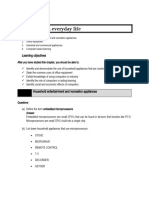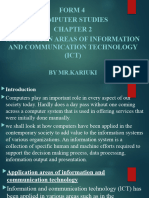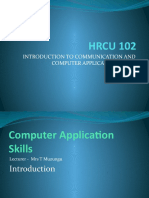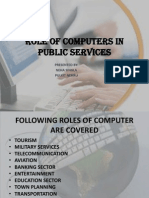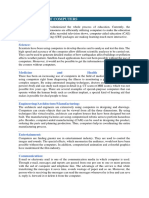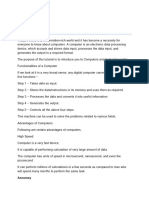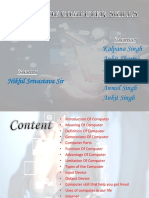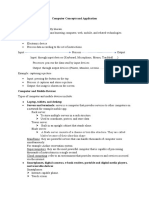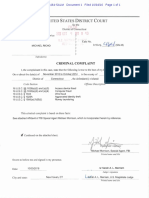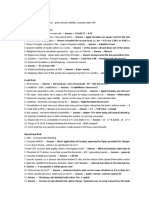COMPUTER APPLICATIONS
Computer applications generally refers to the use of computers. Computers are most important in people’s
daily lives therefore computer technology has become such a part of our daily lives that if were it taken
away from us, we would experience completely different lives.
The following are the areas where computers are usually used;-
- Police Stations - Driver and Vehicle Licensing Centres
- Hotels - Hospitals
- Airports - Customs (at Border posts)
- Banks - Revenue Offices
- Homes - Telecommunications Companies
- Local Businesses - Post offices
- Schools/Educational institutions
Computer Applications can be further be classified into;-
General use, Commercial use, Industrial/Technical use and Scientific use.
1. General use of computers
General use of computers may include the use of computers at home, educational institutions/schools,
leisure centres, etc. Usually the software package designed for general purposes is not written for any
specific businesses but can be used or adapted to suit specific needs. For example the use spreadsheet
package for students’ academic reports. A word processing package can be used by individuals at home
for basic knowledge of computers.
An example of general use is in Education.
Computer are used to aid students learning through Computer Aided Instruction (CAI) and Computer
Assisted Learning (CAL)
CAI and CAL take the form of;
▪ Drills (multiple repetitions) which allows the students to practice concepts through repeated
questions.
▪ Tutorials - These are self-instructional programs that guide the student through new material, but
which allow the student to move at his/her own pace. The student can repeat a lesson if he/she does
not understand it in the first time.
▪ Simulations - These are basically “What if…” analysis situations. Simulations use sound, text and
graphics (multimedia) to bring about an outcome based on a specific scenario.
Computer Aided Instruction (CAI)
These are instructions that help the learner to study through the use of a computer. CAI involves drills
(multiple repetitions) that allow students to practice concepts of repeated questions, tutorials and
simulations.
1
� Computer Aided Learning (CAL)
This refers to the use of computers to enhance learning. e.g. At schools all subjects are to be taught using
computers, The use of encyclopedia for subjects such as Science, etc.
Benefits of E-Learning (Electronic-Learning)
• E-Learning allows people to avoid travel, thus reducing expenses.
• The fact that it takes place in a virtual environment also allows some reduction of paper usage.
• With virtual notes instead of paper notes and online assessments instead of paper assessments, e-
Learning is a more environmentally friendly solution.
• Instructors can share their knowledge across borders allows students to attend courses across physical,
political and economic boundaries.
• Recognized experts have the opportunity of making information available internationally to anyone
interested at minimum costs. This can drastically reduce the costs of higher education making it much
more affordable and accessible to a large number of people at a time.
• E-Learning is self-paced (learners learn at their own pace).
• Learning sessions are available throughout. Learners are not bound to a specific day/time to
physically attend classes. They can also pause learning sessions at their own time.
Advantages of CAL
▪ Available at any time, at any place and when the user wants it.
▪ Allow immediate individual feedback on user understanding.
▪ Can vary the pace and difficulty to suit the individual needs.
▪ Different training styles can be supplied to suit different needs and content.
▪ Training is interactive therefore should motivate.
Disadvantages
▪ Teachers cannot adapt to the needs of CAL within a short period of time, they need training.
▪ CAL is currently expensive and time consuming to develop and modify.
▪ CAL may not be appropriate in learning certain skills, e.g. personal skills when dealing with difficult
customers.
Reference information
Computers are used extensively today as an educational tool to reference information. Many
encyclopaedias are now available in CD-ROMs and internet. The internet is becoming the most popular
means by which research is conducted.
Distance learning
Many institutions are now conducting classes through distance learning using computers; a person may
not to be attending a class in a far country but can just do it through the computer and internet.
Another example of general use is in Leisure and homes.
These include:
• Home computers and home games which may be used for leisure or educational.
• Domestic process control. E.g. green-house temperature control system, burglar alarm system, etc.
2
�• Microprocessor control in home appliances such as automatic washing machine, watch, calculator,
microwave ovens, etc.
2. Commercial use of computers
The applications that fall into this category include;
• Banking
• Stock control
• Reservations (e.g. airline booking)
• Payroll
• Administration in hospitals and other organizations
• Retailing Point of Sale (POS) systems
a. Banking
In our daily lives, we purchase items using debit or credit cards to pay the bill. This means you are
interacting with computers to access your bank account and process the payment.
• Automated Teller Machine (ATM)
These machines allow you to access your bank account to deposit and withdraw cash, to obtain balances,
to transfer funds and to pay bills. With an ATM card or debit card, a pin (Personal Identification Number)
is used access to your bank account.
• Credit cards
Credit cards are similar to debit cards. They give you access to your bank credit account. Your card can
be swiped in-store in order for the magnetic strip that holds the information to be read.
• Smart card
These cards have a microprocessor embedded in them. They are similar to a debit or credit card but hold
more information and more secure. The card information can be updated and stored on the card.
• Electronic fund transfer (EFT)
Using your debit card to pay for item in a store deducts money from your account and transfers it into the
store’s account, by Electronic Funds Transfer (EFT). The balance in both the store’s account and your
account are both updated.
• Home and internet banking
This form of banking gives you the convenience of doing transactions from home, such as checking you
account balance, ordering cheque books, paying bills and applying for loans online.
b. Stock Control
When the cashier in a store swipes the item you are buying over the barcode reader, the reader sends a
message to a central computer so that the number of that particular item in stock should be decreased by
one.
3
�❖ EPOS (Electronic Point Of Sale)
Supermarket checkouts are called electronic point of sale (EPOS) terminals or electronic funds transfer
point of sale (EFTPOS). These refers to terminal that can handle credit or debit card payments. Every
EPOS in a supermarket is connected to a minicomputer in the store, where database of the product
information is stored. The computer is linked to the supermarket’s mainframe computer using a
telecommunications link such as a telephone line or satellite dish.
EPOS Terminal
This EPOS solution provides flexibility to customers seeking to differentiate products including:
• Counter-top payment terminal.
• Mobile payment terminal with wireless or cellular support.
• Handheld data terminals with barcode scanning.
• Full kiosk with barcode scanning, payment and wireless support.
❖ Barcodes
The barcode system is usually represented by the thirteen-digit called European Article Number
(EAN) which identifies a product, its country of origin and manufacture. The last digit of an EAN is a
check digit which is used to make sure the number has been input correctly.
The following are functions of the barcode system;-
- To sell goods to customers and process payments at the checkouts.
- To monitor and control stock by automatically generating orders for more products when the
number in stock falls below level.
- To perform sales analysis to find out which products are selling well and which ones are not.
- To collect data about customers using loyalty cards, which offer points whenever money is spent in
the store.
4
�c. Administration e.g In hospitals
Patients’ records
Most doctors use databases to store information about their patients’ diagnosis, symptoms and
treatment. Record about patients’ health history, as well as their personal information are easily
accessed in the computers
❖ Patient monitoring system
This is a computerised unit that monitors a person’s vital signs, such as blood pressure,
temperature and heart bit rate using sensors attached to the patient. The unit records information
at specific intervals and may sound an alert in the event of dangerous abnormality in the reading.
❖ Expert medical system
This system analyses data and provides answers to questions in the field of medicine. It can
support a doctor who is in doubtful of his decision because of lack of knowledge or experience.
Experts can use this system to arrive at a faster, more accurate conclusion. The theory behind the
conclusion can be given.
3. Technical/Industrial use of computers (Engineering and Manufacturing)
i. Computer Aided Engineering (CAE)
CAE systems analyze engineering designs by simulating varying conditions to determine in advance
whether the designs is likely to work or not. For example an airplane manufacturer mighty be able to
simulate the forces of a hurricane wind on a plane wing using CAE computer.
ii. Computer Aided Design (CAD)
This includes hardware and software to draw such things as engineering and architectural product designs
and clothing lines. This is can also be used by engineers, architects etc. to produce technical drawings
drawn to scale. It allows this design work to be carried out in the computer. CAD may be used to design
curves and figures in two-dimensional ("2D") space; or surfaces, or solids in three-dimensional ("3D")
objects.
Benefits of CAD
• Allows the designer to see the real object before implementing it i.e. if it is good or bad.
• Allows the designer to be able to see the amount of materials needed for constructing such an object
hence not over spending or leading to the project stopping because of lack of materials.
• The length of time it takes you to draw designs is reduced.
• The design produced can be easily be duplicated by the computer and modifications such as the
colour and shape of the design can be easily made.
Features of CAD software
- Accurate drawings/ 3D drawings
5
�- Easy modification of images on the screen
- Scale objects/ zoom facility
- Rotate objects/ can view image from any angle
- Can use real world coordinates/ actual measurements
iii. Computer Aided Manufacture (CAM)
This is whereby after the final product design has been done, it is put in computer controlled machines to
produce the item using the design.
Benefits of CAM in Manufacturing
• Improves machining capabilities:
By using a CAM system, manufacturers can improve their machining capabilities. For example, when
a manufacturer takes up a complex machining task, they rely on the combination software to create a
tool path for machining projects such as molding. The CAM system automates the process, and
makes it easier for manufacturers to complete the project on time.
• Improves client accessibility:
The CAM software allows manufacturers to receive CAD files from their customers. After receiving
these files, they can set up the machining tool path and perform simulations which helps them
calculate the machining cycle times. The software allows manufacturers to minimize errors, execute
projects easily and deliver products to the market within a shorter period of time.
• Helps improve productivity of machines:
Most CAM systems provide high-speed machine tool paths which help manufacturers to minimize
their production cycle times, reduce tools and machine wear. High-speed tool paths enable
manufacturers to improve their cutting quality and accuracy. This type of high- speed machining
helps improve the productivity of the machines used.
• Helps reduce material wastage:
As CAM software feature simulation features, it helps a manufacturer to visually inspect the process
of machining. This allows the manufacturer to capture tool gouges and collisions at an early phase.
This feature contributes to the overall productivity of a manufacturing set up. This also helps them
eliminate mistakes, as well as reduce material wastage.
4. Artificial Intelligence (AI)
Artificial intelligence is one of the most innovative uses of computers today. It can be classified in four
groups;
i. Robotics – is when a computer controlled machines are used in the industry to take the place of a
humans in doing repetitive and dangerous tasks. E.g. spraying cars, assembling fire arms, etc.
ii. Expert systems – these systems provide a great knowledge database of information, which makes
decisions based on the result of questions put to the user. By looking at various possibilities the
6
� computer makes the best informed decision. These systems act as expert in a particular field,
providing a support for decision making.
iii. Natural Language processing - These systems can include voice recognition, voice synthesis and
language comprehension. Voice recognition process the spoken word and match it to a word stored in
a computer’s memory. Voice synthesis systems produce sounds resembling human speech. They can
be used by deaf people to communicate with others.
iv. Simulation of human sensory capabilities – these are complex systems which include the computers
with the ability to see, hear, speak, feel (touch) and smell (detect odour).

